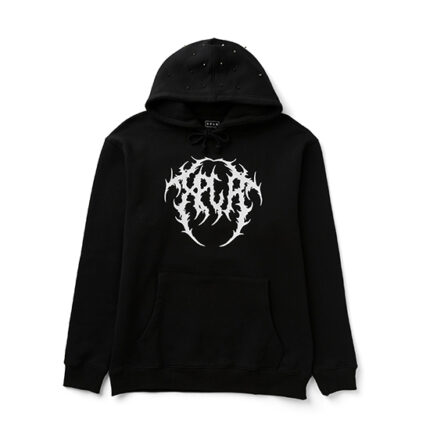Introduction: A Revolution in Fashion
Comme des Garçons, often abbreviated as CDG, is not just a fashion brand — it’s a cultural statement. Founded by Japanese designer Rei Kawakubo in 1969, Comme des Garçons has continuously defied conventions, challenging traditional notions of beauty, structure, and gender in fashion. Translating to “like boys” in French, the brand represents a fearless rebellion against norms and expectations.
The Visionary Behind the Brand – Rei Kawakubo
Rei Kawakubo, the creative genius and founder, has always been known for her unconventional approach. Unlike most designers, Kawakubo did not receive formal fashion training. Instead, she brought a pure artistic perspective to clothing design — one that questions the very definition of fashion. Her work is often described as “anti-fashion”, yet it has become one of the most influential forces in the industry.
The Birth of Comme des Garçons
The brand began in Tokyo and gained attention in the 1970s for its minimalist, deconstructed, and monochromatic designs. When Comme des Garçons debuted in Paris in 1981, the reaction was explosive. Critics were divided — some hailed it as revolutionary, while others dismissed it as radical and unwearable.
However, this controversy only amplified its fame and set the tone for Comme des Garçons’ long-standing reputation for provoking thought through design.
Design Philosophy: Imperfection as Beauty
Kawakubo’s philosophy is rooted in wabi-sabi — the Japanese aesthetic that finds beauty in imperfection and impermanence. Her collections often include asymmetry, raw edges, holes, and distorted silhouettes, challenging the Western ideals of symmetry and perfection.
She once said, “The only way of doing something new is not to look back.” This mindset fuels Comme des Garçons’ constant evolution.
Iconic Collections and Runway Moments
Over the decades, Comme des Garçons has delivered some of the most memorable runway shows in fashion history. From the “Body Meets Dress, Dress Meets Body” (1997) collection featuring padded, abstract body shapes to the “Broken Bride” (2005) and “18th-Century Punk” (2016) themes, each presentation feels more like a conceptual art performance than a fashion show.
Comme des Garçons PLAY – The Heart Logo
While many of Comme des Garçons’ collections are avant-garde and conceptual, CDG PLAY offers a more accessible line. Launched in 2002, PLAY is recognizable by its iconic red heart logo with two eyes, designed by artist Filip Pagowski.
This line includes casual essentials like t-shirts, hoodies, and sneakers — often in collaboration with brands like Converse and Nike. CDG PLAY has become a global streetwear favorite, blending art and everyday wearability.
Collaborations and Cultural Influence
Comme des Garçons has mastered the art of collaboration. Their partnerships with brands like Nike, Supreme, Stüssy, and Gucci have bridged high fashion and streetwear, appealing to a diverse audience.
Beyond clothing, CDG also ventures into perfumes, creating unconventional fragrances such as “Odeur 53” and “Blackpepper”, which challenge the traditional idea of scent itself.
Comme des Garçons Stores – Architectural Masterpieces
Each Comme des Garçons store is a work of art. From the minimalist spaces in Tokyo to the futuristic Dover Street Market in London, Kawakubo treats her retail spaces as living installations. These stores embody her concept of “beautiful chaos,” where fashion, design, and art intersect.
Comme des Garçons in Streetwear Culture
Interestingly, CDG’s rebellious nature has made it a streetwear icon. The brand’s minimalist heart logo and bold collaborations have captured the attention of younger audiences who view CDG as a symbol of individuality and intellectual style.
Perfume Line: The Scent of Rebellion
Comme des Garçons Parfums, launched in 1994, redefined what fragrance could be. Rejecting traditional floral and fruity notes, CDG perfumes often feature metallic, smoky, and woody tones, reflecting the brand’s experimental spirit.
Influence on Modern Designers
Many contemporary designers cite Rei Kawakubo and Comme des Garçons as major inspirations. Brands like Yohji Yamamoto, Issey Miyake, and Junya Watanabe (a protégé of Kawakubo) carry forward her legacy of challenging fashion norms.
The Legacy of Rei Kawakubo
Rei Kawakubo remains an enigma in the fashion world — rarely giving interviews and preferring her work to speak for itself. In 2017, she became one of the few living designers to be honored with a solo exhibition at the Metropolitan Museum of Art titled “Rei Kawakubo/Comme des Garçons: Art of the In-Between.”
Why Comme des Garçons Matters Today
In an era dominated by fast fashion, Comme des Garçons stands as a reminder that fashion can be philosophical, thought-provoking, and deeply personal. It is not merely about aesthetics — it’s about ideas, emotion, and disruption.
Conclusion: The Power of Difference
Comme des Garçons is not for everyone — and that’s precisely its charm. It celebrates individuality, imperfection, and the courage to be different. Rei Kawakubo has turned fashion into a form of storytelling, art, and rebellion — proving that true style lives far beyond trends.



